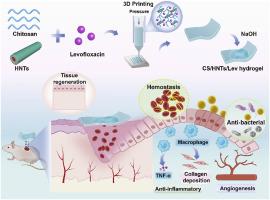管状纳米粘土增强壳聚糖水凝胶的3D打印止血和感染伤口愈合
IF 18
1区 医学
Q1 ENGINEERING, BIOMEDICAL
引用次数: 0
摘要
开发能够快速止血和适应不规则伤口的水凝胶敷料对感染伤口愈合至关重要。可定制的3d打印水凝胶,在伤口管理中备受追捧,由于机械强度弱和生物活性低,仍然是一个持续的挑战。这项工作开发了一种纳米粘土增强的三维(3D)打印壳聚糖(CS)水凝胶,用于控制出血和细菌感染的伤口愈合。高岭土粘土纳米管(HNTs)和CS之间的氢键和静电吸引使CS/HNTs油墨具有剪切减薄、优异的印刷适性、高保真度和形状保持性,使其符合不规则的缠绕形状。HNTs的掺入改善了CS水凝胶的抗压/拉伸强度和止血性能。将抗菌药物左氧氟沙星(Lev)加载到CS/HNTs水凝胶中,使其在创面处持续释放,减轻炎症,促进愈合。体外实验证明CS/HNTs/Lev水凝胶具有良好的抗菌、凝血、血液相容性和细胞相容性。此外,使用感染小鼠模型进行的体内研究表明,复合水凝胶具有快速止血能力、良好的抗菌性能和增强的伤口愈合效果。纳米粘土增强的3d打印CS水凝胶作为止血和伤口愈合敷料在临床应用中具有很大的潜力。本文章由计算机程序翻译,如有差异,请以英文原文为准。

3D printing of chitosan hydrogel reinforced with tubular nanoclay for hemostasis and infected wound healing
Developing hydrogel dressings capable of rapid hemostasis and accommodating irregular wounds is crucial for infected wound healing. Customizable 3D-printed hydrogels, highly sought after for wound management, remain an ongoing challenge due to weak mechanical strength and low bioactivity. This work develops a nanoclay-enhanced, three-dimensional (3D) printed chitosan (CS) hydrogel for controlling bleeding and bacterial-infected wound healing. The hydrogen bonding and electrostatic attraction between halloysite clay nanotubes (HNTs) and CS endow the CS/HNTs ink with shear-thinning, excellent printability, high fidelity, and shape retention, allowing it to conform to irregular wound shapes. Incorporation of HNTs improved compressive/tensile strength and hemostatic performance of CS hydrogel. Furthermore, the antibacterial agent levofloxacin (Lev) was loaded into CS/HNTs hydrogel, which can be continuously released at the wound site to reduce inflammation and promote healing. In vitro experiments demonstrated that CS/HNTs/Lev hydrogel possesses favorable antibacterial, coagulation, blood compatibility, and cytocompatibility. Additionally, in vivo studies using infected mouse models indicated that the composite hydrogel exhibits rapid hemostatic ability, good antibacterial property, and enhanced wound healing efficacy. The 3D-printed CS hydrogel reinforced with nanoclay shows great potential as a hemostasis and wound healing dressing in clinical application.
求助全文
通过发布文献求助,成功后即可免费获取论文全文。
去求助
来源期刊

Bioactive Materials
Biochemistry, Genetics and Molecular Biology-Biotechnology
CiteScore
28.00
自引率
6.30%
发文量
436
审稿时长
20 days
期刊介绍:
Bioactive Materials is a peer-reviewed research publication that focuses on advancements in bioactive materials. The journal accepts research papers, reviews, and rapid communications in the field of next-generation biomaterials that interact with cells, tissues, and organs in various living organisms.
The primary goal of Bioactive Materials is to promote the science and engineering of biomaterials that exhibit adaptiveness to the biological environment. These materials are specifically designed to stimulate or direct appropriate cell and tissue responses or regulate interactions with microorganisms.
The journal covers a wide range of bioactive materials, including those that are engineered or designed in terms of their physical form (e.g. particulate, fiber), topology (e.g. porosity, surface roughness), or dimensions (ranging from macro to nano-scales). Contributions are sought from the following categories of bioactive materials:
Bioactive metals and alloys
Bioactive inorganics: ceramics, glasses, and carbon-based materials
Bioactive polymers and gels
Bioactive materials derived from natural sources
Bioactive composites
These materials find applications in human and veterinary medicine, such as implants, tissue engineering scaffolds, cell/drug/gene carriers, as well as imaging and sensing devices.
 求助内容:
求助内容: 应助结果提醒方式:
应助结果提醒方式:


